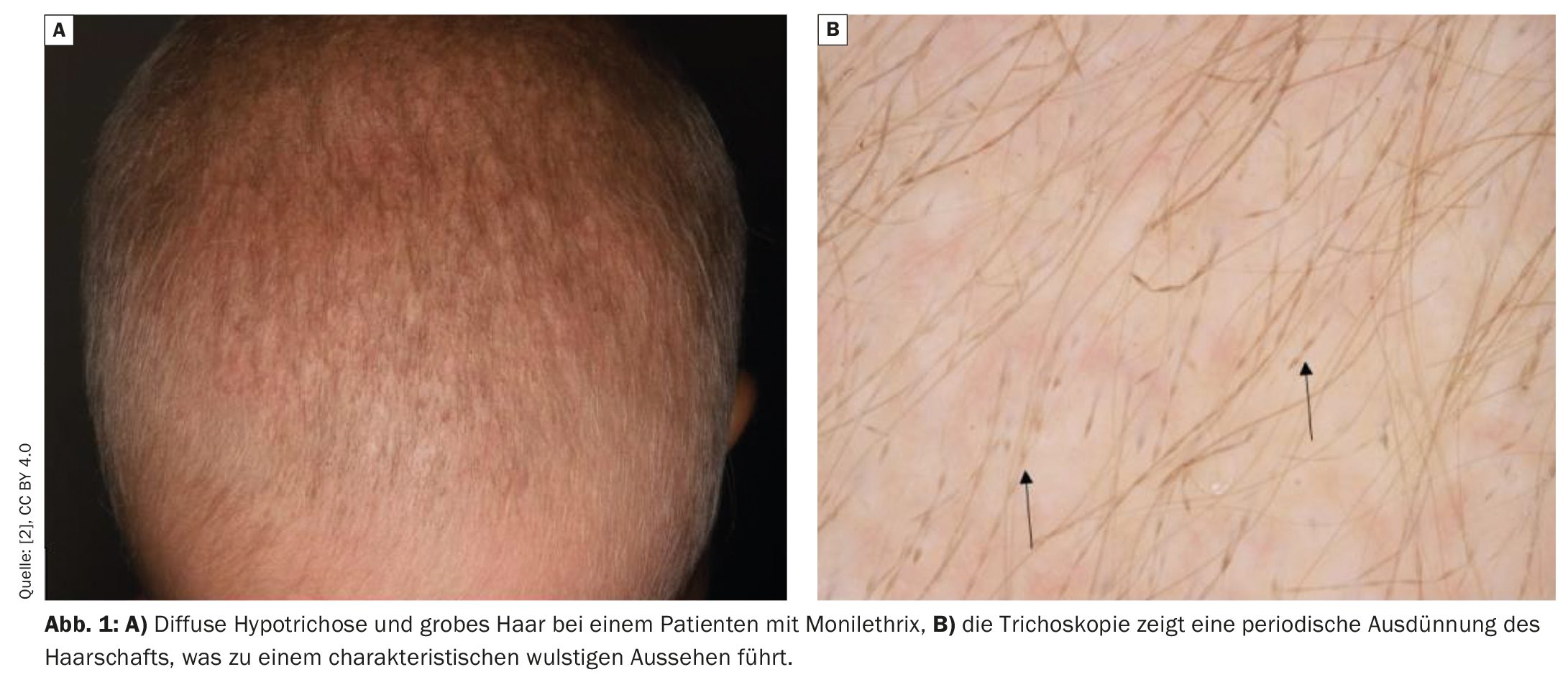Monilethrix (“spindle hair”) is a dysplasia of the hair shaft with a resulting hypotrichosis. In the autosomal dominant form of this genodermatosis, causative mutations were recently identified in addition to the already known pathological gene variants in the keratin 31 gene. It is hoped that the new findings will lead to improved diagnosis of this rare disease.
The term monilethrix is made up of the Latin term for necklace (“monile”) and the Greek word for hair (“thrix”) [1]. The hair anomaly mainly affects the area at the back of the head. The severity within a family is very variable and ranges from little hair loss to complete hairlessness. The trichogram (Fig. 1) shows the characteristic moniliform hair [2]. Recurring knots of normal thickness give the affected “spindle hair” the appearance of a sheaf of pearls. Monilethrix is based on mutations that cause a disrupted network of keratin filaments in the hair cortex cells and lead to increased hair fragility. To date, mutations in the three keratin genes KRT81, KRT83 and KRT86 have been identified in the autosomal dominant form of Monilethrix. A research team led by Prof. Dr. med. Regina Betz from the Institute of Human Genetics at the University Hospital Bonn has carried out exome sequencing in people with suspected Monilethrix in whom no mutations were found in the three already known genes (KRT81, KRT83 and KRT86) and has come across exciting findings [3,4].
Nonsense (stop) mutation discovered in the KRT31 gene
The researchers found a nonsense (stop) mutation in the KRT31 gene in all six affected individuals, which leads to premature termination of the synthesis of the protein [3,4]. With the help of additional sequencing, they were also able to find this mutation in the other affected family members. “Even though the affected families from Germany do not know each other and come from different regions, we were able to show that this mutation most likely originated in a common ancestor and was subsequently passed on over many generations. It remains to be seen whether this mutation can also be found across Europe or even worldwide, but it is likely,” says first author Xing Xiong, a doctoral student at the Institute of Human Genetics at the University Hospital Bonn [3].
The researchers took a closer look at the function of KRT31 [3,4]. The protein encoded by KRT31, like many other keratins, is involved in the construction of skin cells. These proteins assemble into polymeric fiber proteins and thus form the supporting framework for the cell. If there are defects in these proteins, skin and hair diseases develop. Investigations under the microscope using immunofluorescence showed that the “normal” KRT31 is localized in the cytoplasm, while the mutated KRT31 is mainly found around the cell membrane [3,4]. “The localization of the protein in the cell therefore changes with the mutation. This means that its function will also be impaired,” stated Prof. Betz [3].
Effects of the stop mutation
In cooperation with the team from the ImmunoSenstation2 Cluster of Excellence at the University of Bonn led by Prof. Matthias Geyer, Director of the Institute of Structural Biology, Prof. Betz’s team also analyzed the structure of the protein and the possible effects of the stop mutation. As a rule, two keratin molecules always align their ends with the ends of other heterodimers as heterodimers in a double pack, by forming disulfide bonds. “We assume that this disulfide bond can no longer be formed due to the stop mutation and that the function of the protein is therefore impaired,” says Prof. Betz [3]. She is convinced that the inclusion of KRT31 in diagnostic gene panels for hair, skin and nail diseases will improve diagnostics for those affected by hair loss.
Literature:
- “Monilethrix”, https://medlineplus.gov/genetics/condition/monilethrix,(last accessed 18.10.2024).
- Plázár D, et al: Dermoscopic Patterns of Genodermatoses: A Comprehensive Analysis. Biomedicines 2023; 11(10): 2717. www.mdpi.com/2227-9059/11/
10/2717, (last accessed 18.10.2024). - “New gene for “spindle hair” decoded”, University Hospital Bonn, 04.09.2024.
- Xiong X, et al: A nonsense variant in KRT31 is associated with autosomal-dominant monilethrix. Br J Dermatol 2024 Jul 19: ljae298.
DERMATOLOGY PRACTICE 2024; 34(5): 27












